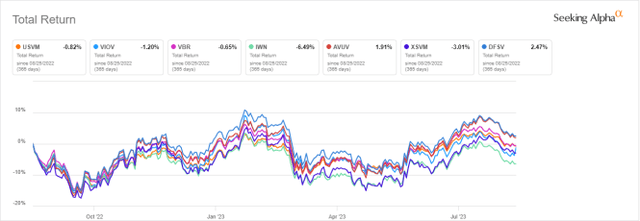This article series aims at evaluating ETFs (exchange-traded funds) regarding past performance and portfolio metrics. Reviews with updated data are posted when necessary.
Strategy and portfolio
VictoryShares US Small Mid Cap Value Momentum ETF (NASDAQ:USVM) started investing operations on 10/24/2017 and tracks the Nasdaq Victory US Small Mid Cap Value Momentum Index. It has 290 holdings, a dividend yield of 1.98% and a net expense ratio of 0.25%. Distributions are paid monthly.
As described by Nasdaq Global Indexes, eligible stocks must be in the Nasdaq US 600 Mid Cap Index or the Nasdaq US 700 Small Cap Index and meet a liquidity threshold. A value score and a momentum score are calculated for every eligible stock. The value score is based on three metrics: book-to-market ratio, net income-to-market capitalization ratio and operating cash flow-to-market capitalization ratio. The momentum score is based on the 6-month and 12-month price returns, excluding the most recent month. A value momentum score is calculated as the average of the value score and the momentum score. Fifteen percent of the eligible universe is selected based on the value momentum score. The index is a modified volatility-weighted index, reconstituted quarterly. The portfolio turnover rate in the most recent fiscal year was 70%, which is quite high.
The portfolio is almost exclusively invested in U.S. companies (over 99% of asset value), with about 83% in small and micro-cap, and 17% in mid-caps (according to Fidelity). Hereafter, I will use the iShares Russell 2000 ETF (IWM) as a benchmark.
The heaviest sectors are industrials (18.6%), consumer discretionary (14.5%), financials (13.8%) and healthcare (13.3%). Other sectors are under 10%. The sector breakdown is not much different from the Russell 2000 index. USVM overweights mostly consumer discretionary.
USVM sector breakdown (chart: author; data: Victory Capital, iShares)
Aggregate valuation ratios are significantly cheaper than for the Russell 2000 index, as reported in the next table.
|
USVM |
IWM |
|
|
Price/Earnings TTM |
9.88 |
12.29 |
|
Price/Book |
1.45 |
1.92 |
|
Price/Sales |
0.77 |
1.18 |
|
Price/Cash Flow |
6.88 |
8.83 |
Source: Fidelity
The top 10 holdings represent only 5.8% of asset value. The next table lists their weights and valuation ratios. The largest holding is below 1%, so risks related to individual companies are very low.
|
Ticker |
Name |
Weight% |
P/E ttm |
P/E fwd |
P/Sales |
P/Book |
P/FCF |
Yield |
|
SAIC |
Science Applications International Corp. |
0.64 |
20.07 |
16.46 |
0.84 |
3.82 |
16.65 |
1.26 |
|
PSN |
Parsons Corp. |
0.62 |
50.88 |
24.81 |
1.36 |
3.05 |
33.80 |
0 |
|
BWXT |
BWX Technologies, Inc. |
0.60 |
29.78 |
24.86 |
2.87 |
7.94 |
N/A |
1.26 |
|
CW |
Curtiss-Wright Corp. |
0.60 |
24.57 |
22.41 |
2.89 |
3.68 |
22.87 |
0.39 |
|
POST |
Post Holdings, Inc. |
0.58 |
18.40 |
18.17 |
0.92 |
1.55 |
17.20 |
0 |
|
NEU |
NewMarket Corp. |
0.56 |
12.70 |
N/A |
1.58 |
4.91 |
19.28 |
1.97 |
|
ORI |
Old Republic International Corp. |
0.54 |
10.42 |
10.77 |
1.03 |
1.28 |
18.08 |
7.28 |
|
NNN |
NNN REIT, Inc. |
0.54 |
19.32 |
19.92 |
8.97 |
1.73 |
34.40 |
5.73 |
|
INGR |
Ingredion Inc |
0.54 |
11.85 |
11.28 |
0.84 |
2.02 |
N/A |
3.07 |
|
ADC |
Agree Realty Corp. |
0.54 |
35.19 |
36.38 |
11.94 |
1.20 |
41.64 |
4.71 |
Ratios: Portfolio123
Historical performance
Since 11/1/2017, USVM has outperformed IWM by about 1.5% in annualized return. Risk metrics (drawdown and volatility) are similar for both funds.
|
Total Return |
Annual Return |
Drawdown |
Sharpe ratio |
Volatility |
|
|
USVM |
44.84% |
6.58% |
-42.38% |
0.35 |
21.96% |
|
IWM |
32.99% |
5.03% |
-41.13% |
0.3 |
22.96% |
Data calculated with Portfolio123
The next chart compares the 12-month total returns of USVM and six other small cap value funds:
- Vanguard S&P Small-Cap 600 Value ETF (VIOV). reviewed here,
- Vanguard Small-Cap Value ETF (VBR), reviewed here,
- iShares Russell 2000 Value ETF (IWN), reviewed here,
- Avantis U.S. Small Cap Value ETF (AVUV), reviewed here,
- Invesco S&P SmallCap Value with Momentum ETF (XSVM), reviewed here,
- Dimensional US Small Cap Value ETF (DFSV), reviewed here.
The two actively managed ETFs, AVUV and DFSV, are leading. USVM is in the middle of the pack. It beats XSVM, the only other fund of this list whose strategy combines value and momentum.
USVM vs. competitors (Seeking Alpha)
Comparison with my Dashboard List model
The Dashboard List is a list of 80 stocks in the S&P 1500 index, updated every month based on a simple quantitative methodology. All stocks in the Dashboard List are cheaper than their respective industry median in Price/Earnings, Price/Sales and Price/Free Cash Flow. After this filter, the 10 companies with the highest Return on Equity in every sector are kept in the list. Some sectors are grouped together: energy with materials, communication with technology. Real estate is excluded because these valuation metrics don’t work well in this sector. I have been updating the Dashboard List every month on Seeking Alpha since December 2015, first in free-access articles, then in Quantitative Risk & Value.
The next table compares USVM performance since 11/1/2017 with the Dashboard List model, with a tweak: the list is reconstituted quarterly to make it comparable with the fund’s underlying index.
|
Total Return |
Annual Return |
Drawdown |
Sharpe ratio |
Volatility |
|
|
USVM |
44.84% |
6.58% |
-42.38% |
0.35 |
21.96% |
|
Dashboard List |
49.84% |
7.21% |
-41.49% |
0.37 |
22.46% |
Past performance is not a guarantee of future returns. Data Source: Portfolio123
The Dashboard List outperforms USVM by 5% in total return. However, ETF performance is real and the model simulation is hypothetical.
Price to Book: a risky concept of value
I like the idea of mixing various ratios to rank value stocks. However, I think most value indexes doing so have two weaknesses, and USVM is no exception. The first one is to classify all stocks on the same criteria. It means the valuation ratios are considered comparable across sectors. Obviously, they are not: my monthly dashboard here shows how valuation and quality metrics may vary across sectors.
The second weakness comes from the price/book ratio (P/B), which adds some risk in the strategy. Historical data show that a large group of companies with low P/B has a higher volatility and deeper drawdowns than a same-size group with low price/earnings, price/sales or price/free cash flow. The next table shows the return and risk metrics of the cheapest quarter of the S&P 500 (i.e.125 stocks) measured in price/book, price/earnings, price/sales and price/free cash flow. The sets are reconstituted annually between 1/1/2000 and 1/1/2023 with elements in equal weight.
|
Annual Return |
Drawdown |
Sharpe ratio |
Volatility |
|
|
Cheapest quarter in P/B |
8.54% |
-81.55% |
0.35 |
37.06% |
|
Cheapest quarter in P/E |
10.71% |
-73.62% |
0.48 |
25.01% |
|
Cheapest quarter in P/S |
12.82% |
-76.16% |
0.47 |
34.83% |
|
Cheapest quarter in P/FCF |
15.32% |
-74.77% |
0.61 |
27.03% |
Data calculated with Portfolio123
This explains why I use P/FCF and not P/B in the Dashboard List model.
Takeaway
VictoryShares US Small Mid Cap Value Momentum ETF (USVM) implements a strategy combining 3 valuation ratios and 2 momentum indicators. It is well-diversified across sectors and holdings. Valuation metrics are attractive, and the fund has slightly outperformed the Russell 2000 since inception. However, recent performance is average relative to other small cap value funds. It beats XSVM, an ETF tracking another index combining value and momentum, but its lags actively managed funds by Avantis and Dimensional. Like most value ETFs, USVM has two shortcomings: ranking stocks regardless of their industries, and relying too much on the price/book ratio for valuation.
Read the full article here












